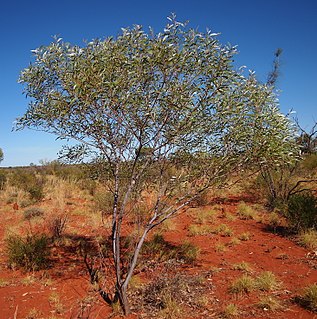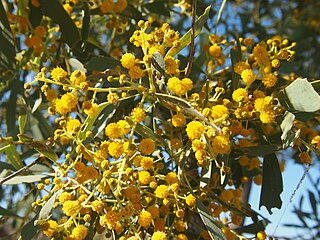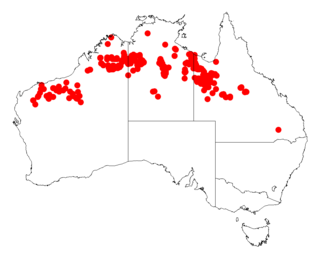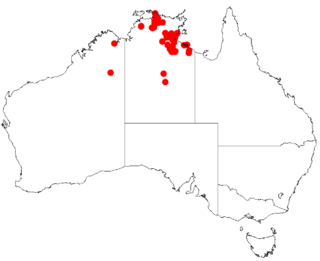
Acacia translucens, commonly known as poverty bush, is a shrub that is endemic to a large area of north western Australia.

Acacia acradenia, commonly known as Velvet Hill wattle and silky wattle, is a shrub or tree belonging to the genus Acacia and the subgenus Juliflorae. It is native to northern and central Australia. The Indigenous Australian group the Nyangumarta peoples know it as walypuna the Alyawarr call it ampwey, the Jaminjung and Ngaliwurru know it as Mindiwirri, the Jaru as binbali or gundalyji, the Kaytetye as ampweye or arwele and the Warlpiri as ngardurrkura.

Acacia conjunctifolia is a shrub belonging to the genus Acacia and the subgenus Juliflorae. It is native to parts of northern Australia.

Acacia drepanocarpa is a shrub belonging to the genus Acacia and the subgenus Juliflorae native to northern Australia.

Acacia gonocarpa, commonly known as wuluru, is a tree or shrub belonging to the genus Acacia and the subgenus Juliflorae. It is native to northern Australia.

Acacia gonoclada, also known as ganambureng, is a tree or shrub belonging to the genus Acacia and the subgenus Juliflorae that is endemic to northern Australia.

Acacia hammondii, also known as Hammond's wattle, is a tree or shrub belonging to the genus Acacia and the subgenus Juliflorae that is native across northern Australia.

Acacia leptophleba is a shrub belonging to the genus Acacia and the subgenus Juliflorae that is endemic to northern Australia.

Acacia limbata is a shrub belonging to the genus Acacia and the subgenus Juliflorae that is endemic across northern Australia.

Acacia orthocarpa, also commonly known as Pilbara weeping wattle, needle-leaf wattle or straight-podded wattle, is a shrub or tree belonging to the genus Acacia and the subgenus Juliflorae that is endemic to tropical parts of northern Australia. The indigenous Nyangumarta peoples know it as yartupu.

Acacia pellita is a shrub or tree belonging to the genus Acacia and the subgenus Juliflorae that is endemic to parts of tropical northern Australia.

Acacia ptychophylla is a shrub belonging to the genus Acacia and the subgenus Juliflorae the is endemic to arid areas of north western Australia.

Acacia richardsii is a shrub belonging to the genus Acacia and the subgenus Juliflorae that is endemic to north western Australia.

Acacia stipuligera is a tree or shrub belonging to the genus Acacia and the subgenus Juliflorae. It is native to arid and tropical parts of northern Australia.

Acacia thomsonii, commonly known as Thomson's wattle, is a shrub or tree belonging to the genus Acacia and the subgenus Juliflorae that native to parts of northern Australia.

Acacia dempsteri is a shrub belonging to the genus Acacia and the subgenus Phyllodineae endemic to south western Australia.

Acacia hemignosta commonly known as the clubleaf wattle, is a tree or shrub of the genus Acacia and the subgenus Plurinerves that is endemic to northern parts of Australia.

Acacia multisiliqua is a shrub or tree of the genus Acacia and the subgenus Plurinerves that is endemic to northern Australia.

Acacia retivenea, commonly known as the net-veined wattle, is a shrub of the genus Acacia and the subgenus Plurinerves that is endemic across northern Australia.

Acacia conspersa is a shrub or tree belonging to the genus Acacia and the subgenus Juliflorae that is native to northern Australia.




















